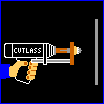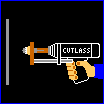Uses and Applications
Stud Welding is used everywhere....
the amazing thing is most of the time you never know it's there.
Products you use everyday, without a thought as to how they are put together or how they function, contain Stud Welding.
Stud Welding is a method of attaching a metal fastener to another metal component.
The fasteners can be ferrous (mild steel, stainless steel), aluminum alloys, brass, copper, gold, silver or one of the many exotic alloys.
Applications vary from "Blazer Buttons" to "Battleships"....
these and some other thought provoking applications are explained below....
|
1. Food service equipment:
Look around next time you go in a "Mcfast" food place....
or any other restaurant kitchen for that matter.
You will see many stainless steel appliances....
microwaves, ovens, mixers, worktops, kitchen hoods, etc.
Now look for the fasteners on all these parts....
you won't see many because they are all put together with weld studs.
Advantages in this application include the fact that the stainless steel finish looks good
(you can't see where the studs are welded) and there are no screw or bolt heads to collect food debris or spills!
|

|

|
2. Architectural lighting:
Weld studs can be used for holding components and cable clips in glamorous, custom, architectural lighting fixtures
to the simply mundane attachment of ballasts in your standard 2ft. x 4ft. fluorescent light fixtures.
|
|
3. Nameplates:
How do they attach those shiny, brass nameplates commonly found outside lawyers offices,
on the company president's door or on burial caskets....they probably have weld studs on the back.
The studs are welded without affecting the polished brass finish.
|

|

|
4. Tools:
Probably the best example is a plasterers' trowel.
If you've ever tried plastering, you don't need me to tell you how difficult it can be to get a smooth surface.
Now if you have a cheap trowel with "spot welds" on the front surface, or even, God forbid, "screws or rivets"
through the blade to hold the handle on....you're job is made worse, if not impossible.
Now a good trowel will have weld studs on the back of the blade, and the handle will be pressed on to these weld studs.
The front face of the blade will be flat and unmarked, this makes the job much easier....
but personally, I would still recommend hiring a plasterer!
|
|
5. Shipbuilding:
Have you ever wondered how they hang everything inside a ship?
I'm not talking about boats or yachts....I'm talking about big ships.... steel ships....
liners, cargo carriers, warships and submarines.
Almost everything on board is held in place with weld studs.
They are attached quickly, from one side, and components can then be bolted to them.
Think about it....would you really want to be cruising in a vessel that had holes drilled and tapped in the side
(bulkheads and hulls for you ship aficionados)....
not a good idea to drill and tap or screw to the side of a submarine either.... use a weld stud!
|

|

|
6. Construction:
Many, many applications.
Probably the most well known, (not as a stud welding application), is the St. Louis Arch.
Made of stainless steel and held together with CD type weld studs.
|
|
7. Elevator panels:
Next time you are in an elevator, take a look at the switch panel.
Most elevators have a polished stainless steel switch panel... with no screws.
All the switches are held on the back with weld studs.
Advantages in this application include no marking on the front face of the panel.... it looks good....
and no screws for vandals to meddle with.
|

|

|
8. Bridges:
Next time you go over a highway bridge take note of the familiar "thump-thump"
sound as you pass from the main highway to the bridge.
At the junction of the main highway and the bridge is a metal "expansion joint"....
put there so the bridge doesn't buckle as it expands in hot weather.
There is a metal plate either side of the gap between the bridge and the highway
(trust me on this.... please don't stop on the way home to take a better look).
On the back of the metal plate which makes up one side of the expansion joint are large, headed weld studs called concrete anchors.
After the plate is dropped into position, concrete is poured behind it to hold it to either the bridge or the main body of the highway.
The concrete sets around the large heads on the studs and effectively holds the expansion joint in place....hence the name concrete anchor.
|
Well, now that you know a little more about stud welding take a moment to browse through our pages,
and see the products used in the examples shown above.
Stud welding isn't for everyone, but I hope, in some small way we have provoked your thought processes....
and maybe, one day, you will remember this page and say "I know how that is done",
or better still "I know how we can do this....STUD WELD IT!"








